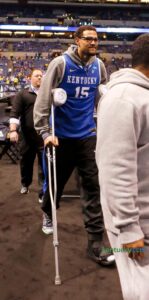UPDATE 4/7/2014
Well, Willie is keeping his head up as best he can. As the lead up to the Championship game draws near, UK’s center has announced he most likely won’t be playing in the game tonight either.
He has shown a lot of class by cheering his heart out on the bench, celebrating with his teammates and not hanging his head and wearing his jersey over his street clothes on the bench during the last couple games as the Cats have advanced through the tourney.
Lexington Podiatry wishes him the best. We understand all too well the hardship and pain in athlete’s eyes when they are told they can’t play during once-in-a-lifetime games. It is never an easy decision for the team doctors or the player involved. The way he has handled himself these past couple weeks makes all of BBN proud and root for the team even harder to #winitforwillie.
ORIGINAL ARTICLE
This past weekend was an eventful one for the University of Kentucky Wildcats as they advanced first to the Elite 8 and then to the Final 4 in the 2014 March Madness tournament.
Tensions were high during Friday night’s game against Louisville when Kentucky center Willie Cauley-Stein went down with an ankle injury early on in the first half, which was later speculated to be a stress fracture.
Though doubt was cast, the ‘Comeback Cats’ (as UK fans affectionately call them) managed to not only advance to the Elite 8 without Cauley-Stein, but beat out Michigan for a chance to play in the school’s 16th Final Four game.
When asked about the likelihood of his return for the much-anticipated game match up with Michigan, Coach Calipari said, “I doubt he plays. He will be on our bench cheering like crazy.”
The Dangers of Stress Fractures in Basketball
Unfortunately, basketball players are all too familiar with stress fractures. Just last year, Louisville player Kevin Ware suffered a gruesome leg injury during the tournament speculated to be the result of an underlying stress fracture.
The horrific injury left the college player with his tibia breaking through the skin. A less dramatic example of this would be when former UK basketball star Anthony Davis suffered from a stress fracture in his foot in 2013. Luckily, he took the proper precautions and finished the season without additional injury.

Stress fractures, which are sometimes called hairline fractures, are small cracks that can remain invisible during an x-ray for up to three weeks, so if you think you might have one, make sure to apply the least amount of pressure and weight to the injured area as possible.
Rapid increase in activity level or training, as well as over-training, can often be the cause of this fairly common injury, which usually occurs in the foot and lower leg.
Sometimes it can simply result from a player twisting or turning their ankle in an awkward way. Anyone with certain risk factors such as flat feet, high arches and osteoporosis are more likely to suffer from one.
Common treatments for stress fractures include stabilizing the fracture with a walking boot, brace or cast to allowing healing. This may also be coupled with crutches.
Don’t underestimate the importance of the RICE Method. Resting your foot, which will require temporarily staying away from physical activity, ice application, compression and elevation are all key to a speedy recovery.
If you are experiencing any foot or ankle pain, call our office at 859-264-1141 or make an online appointment.
